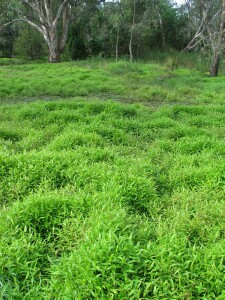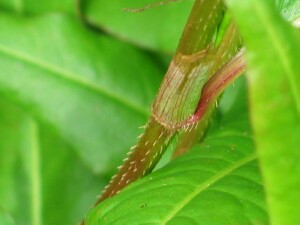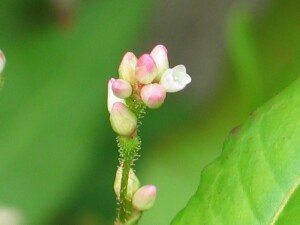Spotted Knotweed
Back | Salinity Indicator Plants Home | Common name home | Scientific name home | Photo Gallery | Glossary
| Spotted Knotweed photos | Family: Dock (Polygonaceae) |
| Scientific Name: | Persicaria praetermissa (syn. Polygonum strigosum) |  Large population of Spotted Knotweed Photo: A J Brown | |||||
Status: | Australian native. | ||||||
Plant Description: | Prostrate to decumbent, perennial herb with creeping stems covered in backwards pointing bristly hairs. Leaves are hastate (with two backward pointing lobes at the base), 2.5-8 cm long and 6-17 mm wide with bristly hairs on the veins and margins. Flower-head of 1-6 small, rather isolated flower clusters. Perianth (flower) segments white or pink, 2.7-4 mm long. Fruit a triangular shaped mid-brown, nut, 2.2-2.5 mm long. | ||||||
Habitat: | Semi-aquatic plant of freshwater environments. Grows in water and on wet flats at the edges of rivers, lagoons and lakes and in marshes, swamps and drainage lines. High waterlogging tolerance.
| ||||||
Comments: | Spotted Knotweed belongs to a group of about 10 species which were once treated as part of the genus Polygonum. The four species left in Polygonum are mainly introduced plants which frequent waste ground or weeds of cropping ground and are not associated with waterlogged situations. Other Knotweeds of wide distribution, include the Australian native Pale Knotweed (Persicaria lapathifolium), Creeping Knotweed (Persicaria prostrata), Slender Knotweed (Persicaria decipiens) and Water-pepper (Persicaria hydropiper). The introduced Persicaria or Redshank (P. maculosa) is a common weed of waterbodies in Gippsland. Its flower-spikes and shorter and broader than in Slender Knotweed | ||||||





